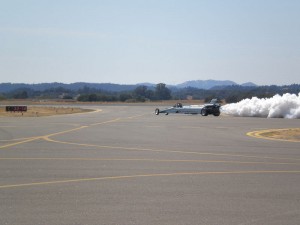 A futuristic British-built rocket car, dubbed Bloodhound, and a team of 34 engineers and scientists behind this supersonic car, will attempt to smash the land speed record.
A futuristic British-built rocket car, dubbed Bloodhound, and a team of 34 engineers and scientists behind this supersonic car, will attempt to smash the land speed record.
The Bloodhound is designed to reach over 1,000 mph in 55 seconds. The attempt will take place on a specially cleared 12-mile stretch of dried-up lake-bed land in Hakskeen Pan in South Africa Kalahari desert in August where 18,500 tonnes of stones have been removed by 300 local workers for five years. The area will be fitted with a water pipeline and 4G phone network. More than 10,000 tourists are expected to watch the record breaking attempt.
The project has been seven years in the making and the design and manufacture of the prototype has taken more than 10,000 hours. Bloodhound has been a dream of Andy Green, 53, a former RAF pilot who will be trying to break his own record of 763mph set in Richard Noble’s Thrust SSC in 1997. The first attempt will only be aiming for 800 mph and to set a new record. Then in 2016, Bloodhound’s engineers will add two extra rockets to the car and will aim to reach over 1,000 mph.
The vehicle is powered by a hybrid engine which is a combination of a Eurofighter jet engine and a cluster of Nammo hybrid space rockets. The engine uses a cleaner form of rocket oxidizer and is expected to produce 135,000 horsepower, which is 11 times the power output of the entire F1 starting grid. The prototype has a slender pencil-shaped aerodynamic body, 44 feet long, four wheels and weighs 7, 5 tonnes.
According to Andy Green and chief engineer Mark Chapman, the speed isn’t everything. They noted that the project aims to ‘engage and inspire a new generation of young people to become engineers of the future’. In order to do that, they are planning to visit 6,000 schools, provide learning materials, run workshops in which children can learn about physics and the car’s engineering. More than 5,700 British secondary schools are now linked to the Bloodhound Education Project and the project will reach as many as 8.5 million children by 2018. In exchange for the educational campaign, the Ministry of Defense would give them three EJ-200 test engines used for the Eurofighter development programme.
